WordPress Plugins For Managing WordPress Post Revisions
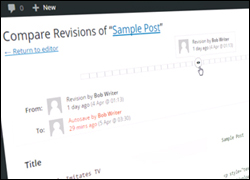
In a separate tutorial, we looked at the WordPress Post Revisions feature, where WordPress saves all your post revisions, so you can always go back to an earlier version of what you have written and restore it.
In this tutorial, we look at a number of WordPress plugins that will help you manage your post revisions.
Revision Management Plugins
As soon as you edit and update a post/page, WordPress begins to store revisions for your content in its database. These show up in a Revisions section below the post editor …

(Viewing the post revisions list)
Autosave and post revisions are no doubt functions that help create a more productive workflow. If you write and edit a lot of content, however, over time the number of revisions can start building up. This can significantly bloat the size of your WordPress database, so it’s important to manage your revisions.

(Your database could be storing lots of unnecessary data)
For example, if you have 250 posts on your site and each post has an average of 10 revisions your database could be storing an extra 2,500 copies of unnecessary data. If your post is approximately 100KB data, then with 2,500 revisions of that post, the total database space wasted is about 250MB.
Fortunately, there are a number of plugins to help you control your revisions and reduce the size of your database. Here are a few of these:
Better Delete Revision
(Better Delete Revision WordPress Plugin)
This plugin deletes redundant revisions of posts from your database as well as database content belonging to each revision such as relationships, tags, meta information, and more.
After the plugin has been installed and activated, you can use it to optimize your WP database without having to log into your server.
Log into your WordPress dashboard, then go to the admin navigation menu and click on choose Settings > Better Delete Revision …
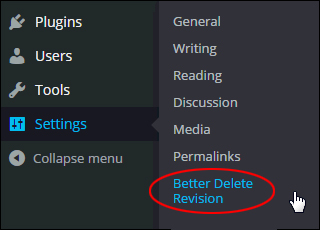
(Better Delete Revision – Settings Menu)
This brings you to the Better Delete Revision Manager area. Click ’Check Revision Posts’ to calculate how many redundant post revisions can be deleted from the WP database …

(Better Delete Revision Manager – Check Revision Posts)
A table of revisions stored in the database will be returned on the screen …
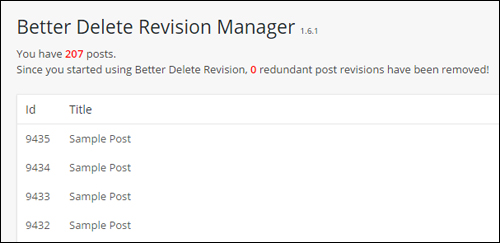
(List of post revisions – Better Delete Revision)
Click on the ‘Yes, I would like to delete them! …’ button to remove all list items from the database, or cancel the task and exit the page …
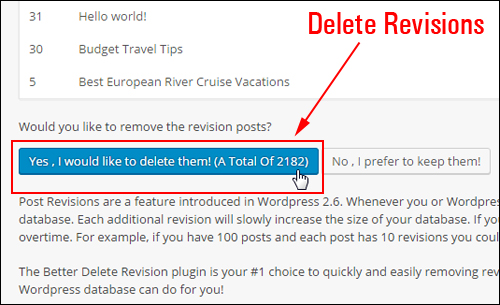
(Delete posts revisions list)
The unnecessary data will be removed from your database …
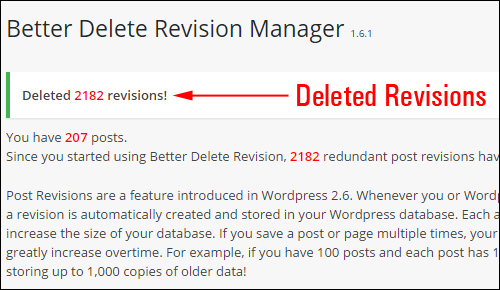
(Revisions deleted)
![]()
As WordPress automatically stores all new revisions, the process will automatically start again (unless you have chosen to turn the feature off). After some time has passed and depending on the amount of content you have published on your site and their related post revisions, we recommend running the tool again to keep your database as light as possible …

(WordPress will automatically begin storing your new revisions again!)
You can also use Better Delete Revisions to optimize your database …

(Optimize the database)
The plugin checks to see if the WP database tables need to be optimized and provides an easy one-click table optimization maintenance routine that does not require you to log into your hosting control panel or mess with complicated database management software …
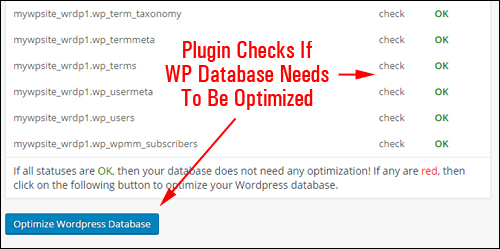
(Better Delete Revision checks if the database tables need to be optimized)
For more details, go here: Better Delete Revision
Optimize Database after Deleting Revisions
(Optimize Database after Deleting Revisions Plugin)
The Optimize Database plugin not only can be used to delete redundant revisions of posts and pages (with the option to keep an ’x’ amount of the most recent revisions) and checks if the database tables need to be trimmed, cleaned, and optimized, it also lets you perform maintenance tasks like:
- Delete trashed posts, comments, and pages
- Delete spammed comments
- Delete ’orphan post meta items’
- Exclude certain tables and specific pages/posts from optimization
- Create a log file of the optimizations
- And more!
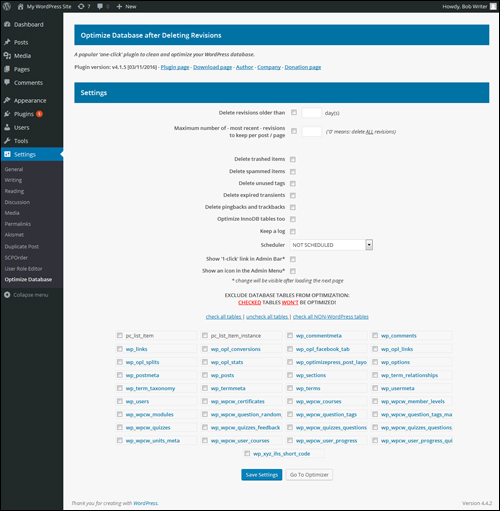
(Optimize Database after Deleting Revisions Plugin – Settings Page)
For more details, go here: Optimize Database after Deleting Revisions – WordPress Plugin
WP-Optimize
(WP-Optimize Plugin)
In addition to performing tasks such as cleaning redundant page and post revisions and checking if the database tables need optimization, WP Optimize also lets you perform the following maintenance tasks:
- Enable/Disable trackbacks for all published posts
- Remove unapproved comments
- Mobile device friendly
- Removal of all trackbacks and pingbacks
- Clean up auto draft posts
- Ability to keep data from selected number of weeks when cleaning up
- Option to add or remove link on WP admin bar
- Enable/Disable weekly schedules of optimization
- View database table statistics (e.g. how much space can be optimized
- E-mail notifications on automatic database cleanups
- Marks dangerous cleanup options in red
- And more!
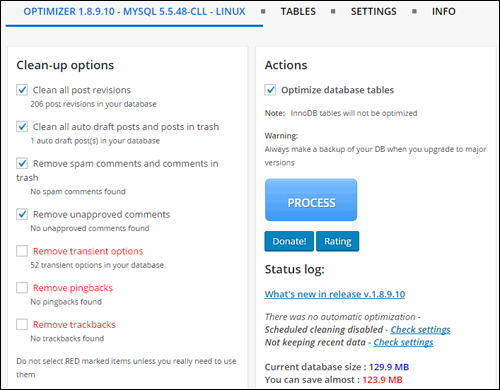
(WP-Optimize – WordPress Plugin Settings)
For more details, go here: WP-Optimize
WP Sweep
(WP Sweep)
WP-Sweep allows you to clean up duplicated, unused, and orphaned data in the WordPress database, including post revisions. This plugin cleans up:
- Auto drafts
- Spammed comments
- Orphaned term meta
- Duplicated comment meta
- Unused terms
- And more!
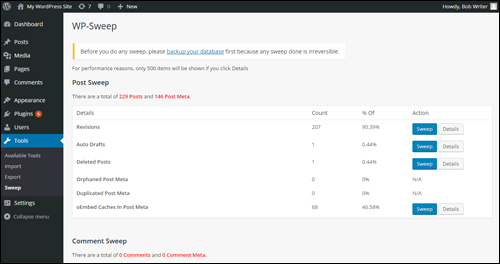
(WP-Sweep Plugin – Settings)
For more details, go here: WP Sweep – WordPress Plugin
Simple Revisions Delete

This lightweight and simple-to-use plugin lets you purge (delete) your posts revisions either individually or all at once.
Once the plugin has been installed and activated, for example, a ‘Purge’ link appears next to the Revisions section in your Publish box (and in other sections of your admin area) allowing you to safely delete revisions.

For more details, go here: Simple Revisions Delete
WP REVISIONS CONTROL

This plugin lets you specify the number of revisions retained for each post type in the Settings > Writing screen.
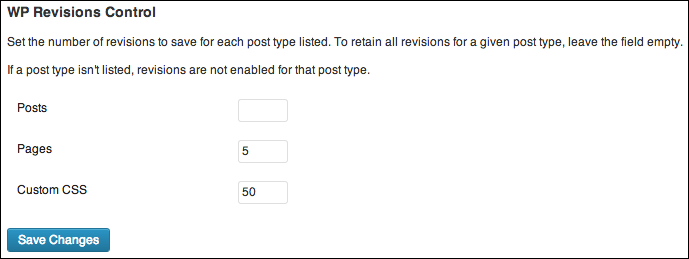
For more details, go here: WP Revisions Control
To view more plugins that can help you manage post revisions and optimize your database, go to Plugins > Add New and search for keywords like “Revisions“, “Optimize Database“, etc …
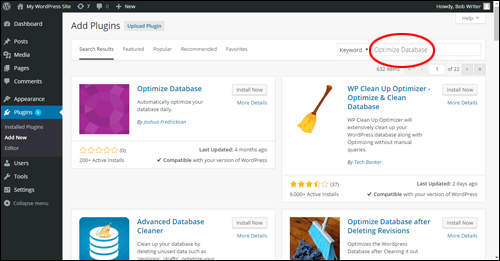
(Add New Plugin – WordPress Plugins Menu)
We hope that you have found the above information on plugins that will help you manage your WordPress post revisions useful.

***
"Wow! I never knew there's so much to learn about WordPress! I bought one of the WordPress for Dummies three years ago, such authors need to be on this course!" - Rich Law, Create A Blog Now
***



